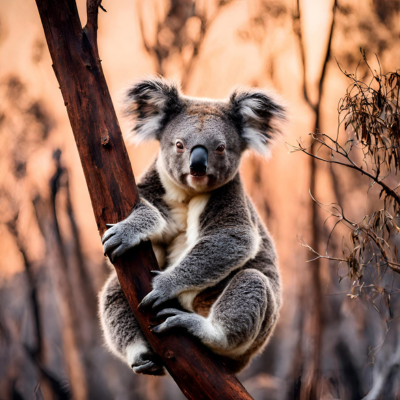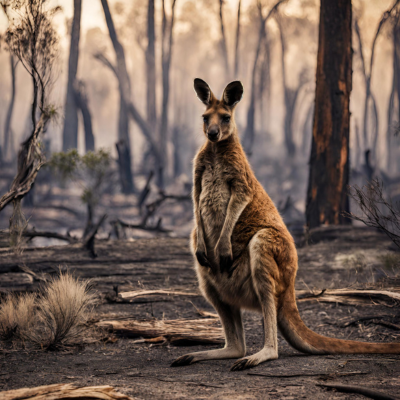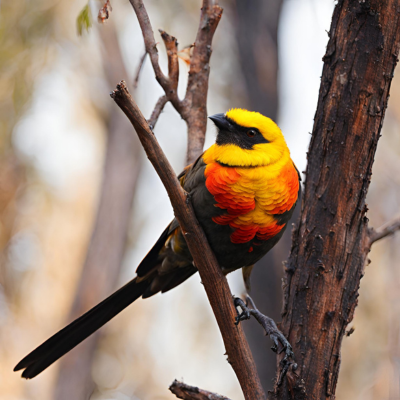In this article:

Introduction
In the heart of Australia's breathtaking landscapes, where nature's beauty unfolds in sprawling forests and expansive grasslands, lies an elemental force that shapes, challenges, and transforms: the bushfire. These fiery phenomena, while a natural part of the Australian ecosystem, carry with them a legacy of both creation and devastation.
This article seeks to unravel the complex tapestry of bushfire facts, shedding light on their profound impacts on human life, wildlife, and the environment. Through exploring historical patterns, recent devastations, and the relentless challenge posed by climate change, we aim to provide a comprehensive overview that not only informs but empowers and inspires proactive change.
Definitions
Wildfire terminology can vary based on geography or the type of fuel that's primarily burned.
Bushfires are uncontrolled blazes that occur in vegetated areas like forests, grasslands, and bushland. Australia's unique climate and landscape make it particularly susceptible to these natural disasters.
It's helpful also to be aware of other terms that are often used in the Australian context when discussing wildfires, such as:
Controlled Burns/Backburns: Intentional fires set to reduce flammable material and mitigate the risk of larger fires.
Fire Season: The period of the year when bushfire risk is highest, typically during hot, dry months.

Historical Context: Australia's Long Relationship with Fire
For tens of thousands of years, Aboriginal and Torres Strait Islander peoples have strategically used fire as a tool for land management. Controlled burns helped regenerate landscapes, promoted biodiversity, and reduced the risk of large, uncontrolled wildfires.
The arrival of European settlers drastically changed the dynamics of fire in Australia. Land clearing for agriculture and the suppression of traditional burning practices led to a buildup of flammable vegetation. This, in turn, contributed to a shift in the frequency and intensity of bushfires.
Australia has witnessed some of the world's most destructive bushfires. Events like the Black Friday bushfires of 1939, the Ash Wednesday fires of 1983, and the more recent Black Summer of 2019-2020 highlight the immense scale and devastating impact these fires can have on communities and ecosystems.
Australia Bushfire Facts: Recent Devastation
In 2019-20, Australia witnessed another intense bushfire season, with significant damage across various regions. Over 12 million hectares of land were scorched, affecting both densely forested areas and open grasslands. The sheer scale of destruction has highlighted the urgent need for proactive strategies to combat such large-scale wildfires.
More recently, in 2022 and 2023, bushfires ravaged areas in New South Wales, with a blaze of 250km “triggering the region's first emergency fire warning in two years."
Between 2001 and 2022, Australia experienced a significant loss of tree cover, with 6.32 million hectares (Mha) lost due to fires and an additional 2.53 Mha lost due to other factors. The year that saw the highest tree cover loss from fires was 2020, accounting for a staggering 1.96 Mha, which represented 83% of all tree cover loss for that year.

Impacts of Australian Bushfires
Air Quality
Air quality is a growin concern among Australians, and bushfires have emerged as a major contributor. According to Air Quality News, Australia witnessed its most severe air quality crisis to date in 2020.
During that year, certain areas of Sydney experienced PM2.5 levels soaring close to 400µg/m3. The World Health Organization cautioned that such pollution levels could lead to severe health consequences for residents.
The enduring impacts of compromised air quality and smoke inhalation were far-reaching, resulting in over 3,000 hospitalizations due to cardiovascular and respiratory ailments.
A study published in the journal Nature revealed that the bushfires in 2020 had an alarming impact on air quality, with the ozone layer depletion reaching up to 5% that year. While the depletion was temporary, scientists have warned that further fires could delay the recovery.
Furthermore, research has shown that bushfire smoke, particularly ozone (O3) and particulate matter (PM10), has significant health impacts. Saberian et al. (2017) found a statistically significant causal link between bushfire smoke and health outcomes in Australian cities. They reported that bushfires in Eucalypt forests to the west of Sydney increased PM and O3 concentrations in the city and were associated with a 5% increase in non-accidental mortality.

Wildfires and Their Impact on the Environment
The repercussions of these devastating wildfires extend beyond human life, profoundly affecting wildlife. During bushfires in the 2019-2020 period, the number of displaced animals reached an astonishing figure of nearly 3 billion, three times higher than the initial estimates.
The animals affected by these fires face dire outcomes, either perishing directly from the flames or indirectly due to the destruction of their habitats, leading to a lack of food and water. In some cases, entire species were eradicated as they were unable to evacuate or adapt swiftly enough to the rapidly changing environments caused by the fires.
Amidst ongoing discussions, there remains significant debate about the recovery prospects for certain species, as their habitats have been ravaged by the relentless onslaught of flames or the inhalation of smoke and ash that follows a fire.
Climate Change Impact
Climate change is making Australian bushfires worse. Rising temperatures, prolonged droughts, and changes in rainfall patterns are creating the perfect conditions for fires to ignite and spread rapidly.
The incidence of bushfires in Australia has been increasing, with a 40% increase in events from 2008 to 2013. The areas most prone to bushfires are in tropical and subtropical areas in Queensland and northern New South Wales.
An academic study in 2020 explored the causes of the 2019-2020 Black Summer bushfire season. The researchers identified several factors contributing to the bushfires, including ongoing drought, surface soil moisture, heat waves, and fuel moisture content - all conditions linked to climate change.
Species and Ecosystems: Bushfires and Australia's Unique Biodiversity
Australia is a continent teeming with unique plants and animals, many of which are found nowhere else on Earth. Bushfires pose a significant threat to this precious biodiversity.
Bushfires have devastating consequences for wildlife:
Direct Loss: Animals are killed directly in the flames or succumb to injuries and smoke inhalation later.
Habitat Destruction: Vast areas of bushland, forests, and grasslands are incinerated, leaving animals without homes or food sources.
Long-term Decline: Even after the fires subside, the loss of habitat and disruption to ecosystems lead to population declines and can push vulnerable species closer to extinction.
Some of the iconic Australian animals most severely affected by bushfires include:
Koalas: Slow-moving and dependent on eucalyptus trees, koalas are particularly susceptible to bushfires.
Kangaroos and Wallabies: Large populations perish in fast-moving fires, impacting the broader ecosystem
Birds, Reptiles, and Insects: Countless smaller species are vital to the food web and suffer immense losses during bushfires.
Fire doesn't just impact individual species; it throws entire ecosystems off balance. The loss of vegetation can lead to erosion, invasive species taking over, and altered predator-prey relationships.
Global Comparisons: Australian Bushfires in Context
Comparing bushfires across regions helps us understand the different factors driving wildfire risk, as well as their varied impacts.
Australian bushfires are notorious for their sheer size and intensity. The factors which contribute to this include:
Vast Landscapes: Australia has huge tracts of relatively unpopulated land, allowing fires to burn across vast areas.
Flammable Vegetation: Eucalyptus trees are highly flammable due to their oil content, fueling the rapid spread of fire.
Extreme Weather: Heatwaves, droughts, and strong winds create ideal conditions for catastrophic bushfires.
While Australian bushfires have unique characteristics, the increasing threat of wildfires is a global concern. Climate change, land-use patterns, and the expansion of the Wildland-Urban Interface (WUI) are exacerbating fire risks in many regions of the world.
Further Reading
Understanding bushfires and their profound impacts requires a multifaceted approach, combining knowledge from history, science, community experience, and policy. To deepen your comprehension and stay informed, we've compiled a comprehensive list of resources:
Department of Fire and Emergency Services (Western Australia): Provides information on bushfire preparedness, warnings, and current incidents.
Rural Fire Service (New South Wales): Offers bushfire safety advice, resources for property owners, and the latest fire updates.
Australian Disaster Resilience Knowledge Hub: A collection of resources, research, and case studies related to bushfires and other natural disasters.
CSIRO (Commonwealth Scientific and Industrial Research Organisation): Australia's national science agency, conducting research on climate change, bushfire behavior, and risk mitigation.
Bushfire and Natural Hazards Cooperative Research Centre: A collaboration between researchers and emergency services focused on improving bushfire management and community resilience.
We have also written a comprehensive article on Bushfire Prevention in Australia, which looks at a range of mitigation approaches to this growing and increasingly urgent issue.
Conclusion
In conclusion, the journey through Australia's bushfire landscape is one of learning, action, and unity. The facts and narratives shared in this article illuminate the vast scope of challenges and the critical importance of preparedness, community, and innovative solutions.
The impacts of bushfires extend far beyond the flames, touching every aspect of Australian life—from our environment and wildlife to our communities and individual well-being. Yet, within this challenge lies an opportunity—an opportunity to build a more informed, prepared, and resilient society. By embracing the knowledge shared, engaging in community efforts, and supporting policies and practices that protect and preserve our landscape, we can forge a safer path forward.





